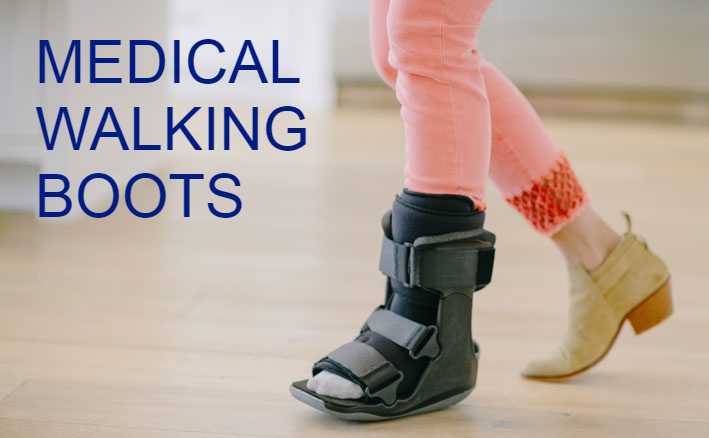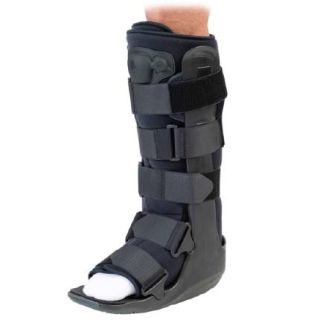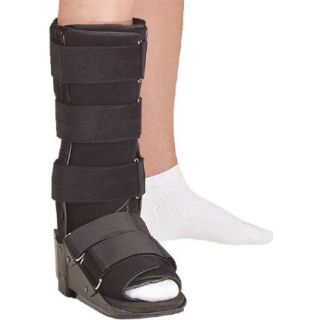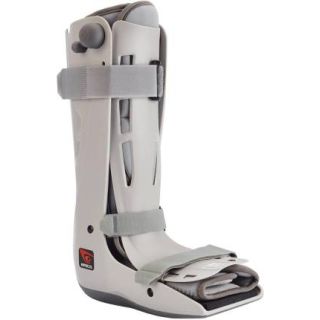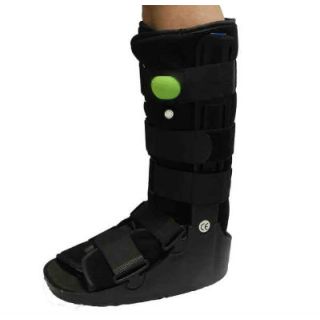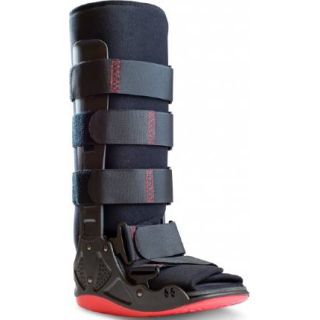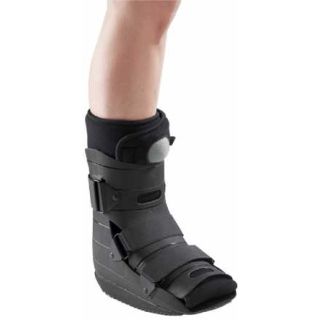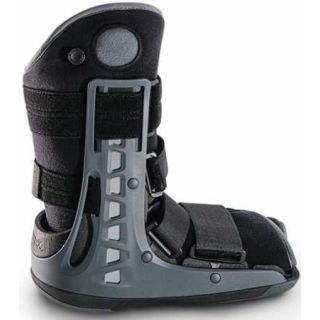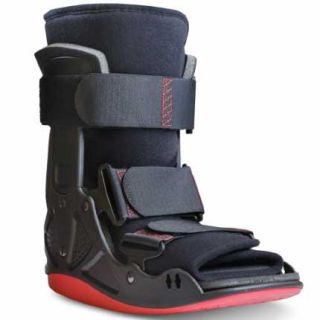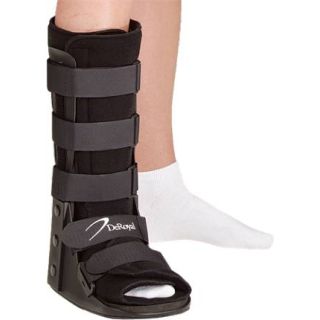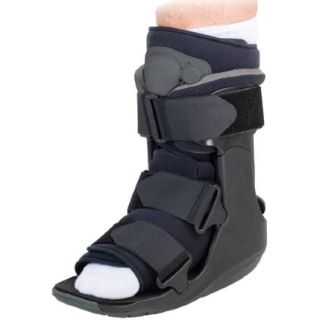Medical Walking Boot Guide - Find The Right Boot For Your Injury
June 12, 2023What Is A Walking Boot?
A walking boot, also referred to as an orthopedic boot or medical boot, is a specialized device utilized for safeguarding, supporting, and immobilizing the foot and ankle during the recovery process following injuries or certain surgical procedures. It is designed to offer stability, decrease weight-bearing forces, and encourage proper alignment while permitting limited mobility. Walking boots are available in various types and styles, such as standard walking boots, pneumatic (air) walking boots, or cam walker boots, each tailored with specific features and indications. Healthcare professionals often prescribe them to assist in the healing and rehabilitation of foot and ankle injuries.
What Is The Purpose Of A Medical Walking Boot?
Medical walking boots play a crucial role in the recovery and rehabilitation of injuries. Their purpose is to provide necessary support, stability, and protection to the foot and ankle as they heal. By immobilizing the affected area, these boots prevent further damage and minimize movement. They also help distribute weight and alleviate pressure, promoting healing. Additionally, medical walking boots allow individuals to engage in controlled movement and gradual rehabilitation exercises. These boots are designed to be customizable and comfortable, ensuring optimal healing conditions. However, it is advisable to consult healthcare professionals for specific guidance on the duration of usage and follow-up care to maximize the benefits of these boots in injury recovery and rehabilitation.
How Do Walking Boots Provide Support To An Injured Foot And Ankle?
These specialized boots offer vital support by immobilizing the injured area and facilitating healing.
Walking boots are carefully crafted to provide stability to the foot and ankle during the recovery process. Constructed from robust materials like plastic or fiberglass, they restrict excessive movement, offering a solid framework for healing. These boots cover the lower leg and foot, ensuring comprehensive support.
To ensure effective support, walking boots feature adjustable straps or closures for a secure and personalized fit. They are designed with ample space to accommodate dressings or bandages while maintaining proper alignment and stability.
By immobilizing the injured foot and ankle, walking boots prevent further harm and minimize the risk of reinjury. This immobilization is especially crucial for fractures, sprains, and ligament tears, as it helps maintain a stable position for healing.
Walking boots also help distribute body weight evenly across the foot, reducing pressure on the injured area. This redistribution eases strain on bones and tendons, promoting a more balanced and natural walking pattern.
With the support provided by walking boots, individuals can bear weight on the injured foot while minimizing pain and discomfort. This allows them to stay mobile and carry out daily activities with a reduced risk of worsening the injury.
Remember, the level of support and immobilization may vary depending on the severity of the injury. It is essential to follow healthcare professionals' guidance on the proper use of walking boots and any accompanying rehabilitation exercises to ensure the best support and recovery outcomes.
How Do Walking Boots Immobilize The Foot And Ankle To Promote Healing?
These boots provide support by:
- Limiting Movement: Walking boots have a durable outer shell made of materials like plastic or fiberglass. This rigid structure restricts the foot and ankle's range of motion, preventing further damage and creating a stable environment for recovery.
- Ensuring a Secure Fit: Adjustable straps or closures on walking boots allow for a personalized and snug fit. These straps hold the foot and ankle securely, preventing any unwanted shifting or rotation. This secure fit ensures proper immobilization, even during weight-bearing activities.
- Stabilizing Joints: Foot and ankle injuries often affect the stability of joints, including ligaments and tendons. Walking boots provide external support, compensating for weakened or damaged structures. This stabilization reduces stress on the injured area, facilitating healing.
- Offloading Pressure: Walking boots distribute body weight evenly across the foot, reducing pressure on the injured area. By doing so, they minimize strain on bones, joints, and soft tissues, creating a more favorable environment for healing and reducing discomfort.
- Offering Protection: Walking boots act as a protective barrier, shielding the injured foot from potential impacts and accidental bumps. This protection is crucial during the early stages of recovery when the area is most vulnerable.
Overall, walking boots immobilize the foot and ankle, allowing them to rest and heal effectively. It is essential to follow healthcare professionals' guidance on the appropriate duration and usage of walking boots to ensure optimal recovery.
How Do I Know If I Need A Walking Boot?
Determining whether you require a walking boot is best left to medical professionals who can assess your specific foot or ankle injury. However, some indicators that might suggest the need for a walking boot include intense pain, swelling, an inability to put weight on the affected foot or ankle, noticeable instability, or a confirmed fracture. If you have undergone surgery or experienced a significant ligament or tendon injury, a healthcare provider may recommend a walking boot to aid in healing and provide support throughout the recovery process. It is crucial to consult with a medical expert to receive accurate and personalized advice based on your unique circumstances.
What Injuries Require A Walking Boot?
Walking boots are commonly recommended for a range of foot, ankle, and lower leg injuries. These include fractures, sprains, strains, tendonitis, stress fractures, and post-surgical recovery. Walking boots provide stability, support, and protection to the injured area, helping to promote healing and reduce strain. However, it's important to consult with a healthcare professional for an accurate diagnosis and appropriate treatment recommendation.
Is It Easier To Walk With A Walking Boot?
Walking with a walking boot can vary in difficulty depending on personal circumstances and the nature of the injury. While these boots offer stability and support, they can be bulkier and heavier than regular shoes, which may present some challenges. However, they are specifically designed to reduce stress on the injured foot or ankle, making walking more comfortable and enabling a more natural walking pattern. Adhering to healthcare professionals' advice and gradually adapting to walking with the boot is crucial for optimal healing and minimizing discomfort.
Do You Wear A Sock With A Walking Boot?
Yes, it is generally advisable to wear a sock with a walking boot. Wearing a sock serves several purposes:
- Comfort: A sock provides a layer of padding and helps prevent direct contact between the boot and your skin, reducing friction and discomfort.
- Moisture control: Socks help absorb sweat and keep your foot dry, promoting better hygiene and reducing the risk of skin irritation or infections.
- Protection: A sock acts as a barrier between your foot and the walking boot, offering an extra layer of protection and minimizing the chance of rubbing or chafing.
When selecting a sock to wear with a walking boot, choose a breathable and moisture-wicking material to keep your foot cool and dry. Ensure the sock fits comfortably and doesn't apply excessive pressure or hinder blood circulation. It's a good idea to consult with your healthcare provider or follow the specific recommendations provided by the manufacturer of your walking boot regarding sock selection and use.
How Tight Should The Walking Boot Be?
Ensuring the proper fit of a walking boot is crucial for both comfort and effective support during the healing process. Consider the following guidelines:
- Comfortable Snugness: The walking boot should provide a secure fit around the foot and ankle without causing any pain, pressure points, or restricted blood flow.
- Reasonable Range of Motion: While wearing the boot, you should be able to move your toes and ankle comfortably. However, excessive movement that could hinder healing should be limited.
- Stability: The boot should offer stability to the injured foot or ankle by minimizing unnecessary side-to-side or rotational movements that could worsen the injury.
- Follow Instructions: It's important to adhere to the fitting instructions provided by the manufacturer or healthcare professional. They may have specific recommendations for adjusting straps, closures, or inserts to achieve the ideal fit.
Remember, each injury and individual may require unique considerations. To ensure the walking boot is properly fitted for your specific condition, consulting with a healthcare provider or orthopedic specialist is advised.
Do You Sleep With A Walking Boot?
It is important to consult with your healthcare professional for guidance on whether you should wear a walking boot while sleeping. Their advice may vary based on the nature and severity of your injury. They may recommend keeping the boot on during sleep for continuous support or suggest removing it to ensure comfort and proper circulation. Personalized guidance from a healthcare provider is crucial in making the right decision.
What Comes After A Walking Boot?
Following the use of a walking boot, the subsequent step in the recovery process usually involves moving towards less restrictive footwear or orthotic devices. This can entail transitioning to supportive shoes, employing ankle braces, or engaging in physical therapy to restore strength and mobility. The exact course of treatment differs based on the nature of the injury, healing progress, and the advice of the healthcare provider. It is crucial to adhere to the recommendations of your healthcare professional for a secure and successful recovery.
Is it Ok To Walk In A Walking Boot Without Crutches?
It is generally considered acceptable to walk in a walking boot without crutches, but it's crucial to consult your healthcare provider for guidance. Walking boots offer support and protection for injured feet or ankles, allowing for partial or full weight-bearing depending on the injury severity. Following your healthcare professional's advice is essential to ensure proper healing and prevent any potential complications.
Is A Walking Boot Painful?
Wearing a walking boot can result in some discomfort or initial pain as your body adapts to the added support and immobilization. However, it's crucial to distinguish between typical discomfort and excessive pain. It's normal to experience some pressure, soreness, or discomfort initially due to the injury and the boot itself. If the pain becomes severe or unmanageable, it's best to seek guidance from your healthcare professional to ensure proper fit and address any potential complications or concerns with the boot.
Can I Walk Without My Walking Boot?
It is crucial to consult with your healthcare professional before considering walking without your walking boot. Making such a decision without their guidance can impede the healing process and potentially cause additional harm. Adhering to the prescribed treatment plan and following the advice provided by your healthcare professional is essential for a safe and successful recovery. They will assess your progress and determine the appropriate time to transition away from the walking boot.
How Long Will I Have To Wear A Walking Boot?
The length of time you will need to wear a walking boot depends on various factors such as the type and severity of your injury, as well as your individual circumstances. Although many people wearing a walking boot for1-6 weeks on average, it is important to consult with your healthcare provider for an accurate assessment and personalized recommendation. They will evaluate your specific condition, monitor your healing progress, and provide guidance on the appropriate duration for wearing the walking boot. Adhering to their professional advice and attending follow-up appointments will ensure that you wear the boot for the necessary timeframe to support optimal healing and recovery.
Can You Drive With A Walking Boot?
Driving while wearing a walking boot can be possible in certain situations. However, it's crucial to consider your ability to operate the vehicle safely. Factors such as pedal control and quick response times are important for driving. The size and bulkiness of the boot may limit your mobility and affect your comfort while driving. It's essential to consult local regulations and seek advice from your healthcare provider for specific guidance on driving with a walking boot. They can assess your condition, offer safety recommendations, and inform you about any relevant restrictions or accommodations during your recovery.
Can I Take My Walking Boot Off When Resting?
It's generally recommended to adhere to the instructions provided by your healthcare provider regarding wearing the walking boot. However, it's possible that you may be able to take it off during periods of rest. It's crucial to consult your healthcare professional for specific guidance based on your injury and recovery. They can advise you on when it's appropriate to remove the boot and how long you can rest without it. Keep in mind that the walking boot offers support and protection, so removing it without proper guidance may impede healing or increase the risk of further harm.
How Do You Walk Up And Down Stairs With A Walking Boot?
Walking up and down stairs with a walking boot requires special attention and care. Here are some guidelines to follow:
- Walking Upstairs:
- Approach the stairs facing forward.
- If there's a handrail, use it for support.
- Lift your uninjured foot and place it on the step above.
- Shift your weight onto your uninjured foot.
- Push yourself up using the handrail and your uninjured leg.
- Bring your injured foot and the walking boot up to the same step.
- Repeat these steps for each stair, taking your time and maintaining your balance.
- Walking Downstairs:
- Approach the stairs facing forward.
- Hold onto the handrail for support.
- Lower your injured foot and the walking boot onto the step below.
- Transfer your weight onto your injured foot.
- Use the handrail and your uninjured leg for stability as you lower your body.
- Bring your uninjured foot down to the same step.
- Repeat these steps for each stair, descending slowly and with control.
Always be cautious and go at your own pace when using stairs with a walking boot. If you feel unsure or need assistance, consider using crutches or asking someone for help. It's also recommended to consult with your healthcare provider for personalized advice on safely navigating stairs based on your specific injury and recovery progress.
To summarize, medical walking boots play a critical role in supporting injury recovery and rehabilitation. Here's a recap of their importance:
- Immobilization: Walking boots provide stability and restrict movement, allowing injured feet and ankles to heal properly and prevent further damage.
- Support and Protection: These boots offer vital support to the injured area, reducing pain and protecting it from external forces and impacts.
- Controlled Mobility: While limiting movement, walking boots enable controlled mobility, allowing individuals to engage in necessary daily activities during the recovery process.
- Facilitated Healing: By immobilizing the foot and ankle, walking boots promote proper alignment and aid in the healing process, minimizing the risk of complications.
- Gradual Progression: Walking boots assist in the gradual transition from non-weight bearing to partial weight-bearing, helping restore strength, stability, and mobility to the injured area over time.
It's important to note that the use and duration of wearing a walking boot may vary depending on the injury's nature and severity. Seeking guidance from a healthcare professional or orthopedic specialist is advisable to ensure the proper use of a medical walking boot and maximize its benefits.
Sources:
